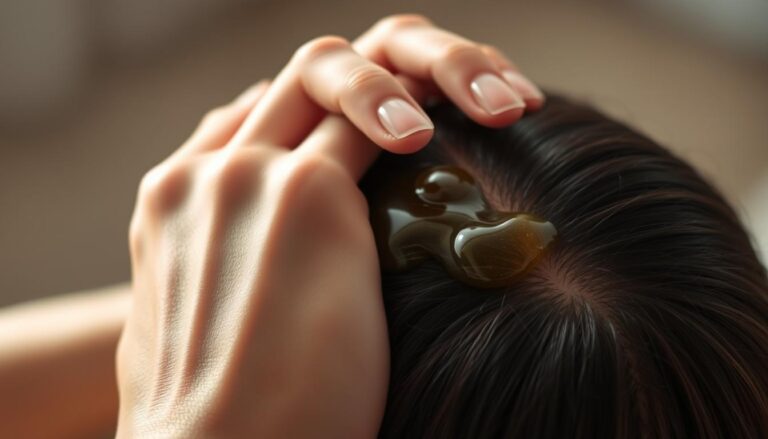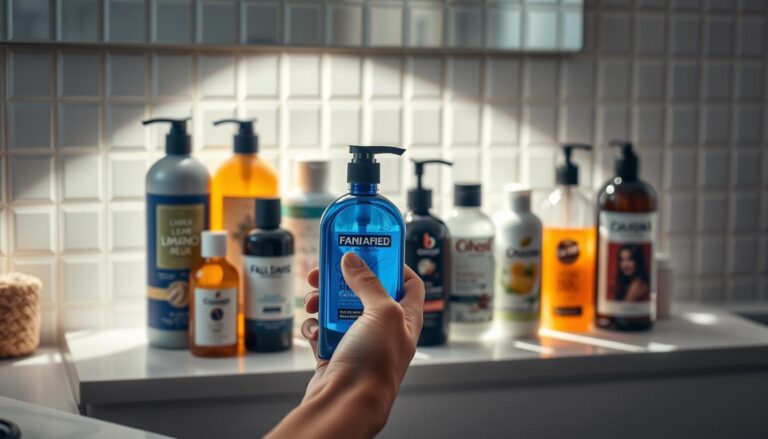At Glowskinhub.com, we believe beauty isn’t just a look—it’s a feeling
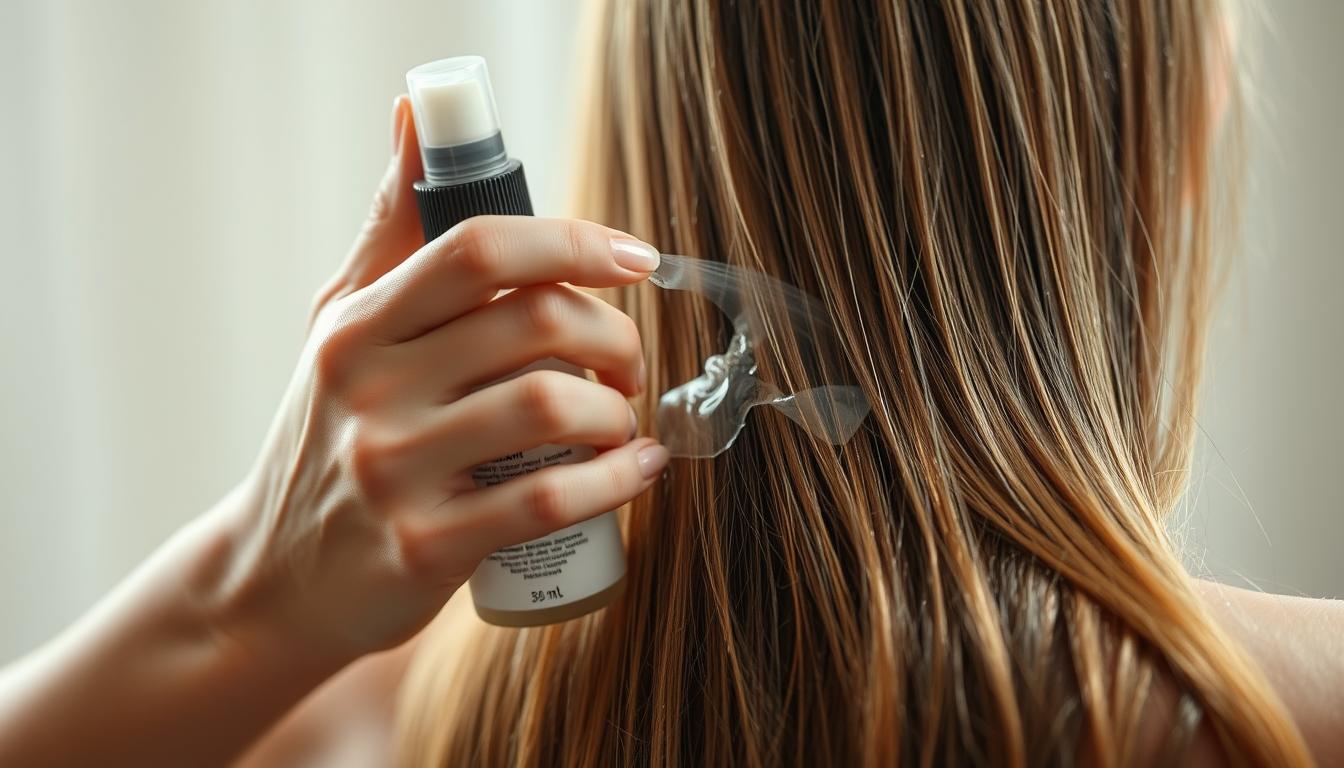
Heat protection tips before straightening hair
Straightening hair can be a daily ritual for many, but it comes with its risks, particularly when it comes to heat damage. Using heat styling tools without proper protection can lead to dryness, brittleness, and breakage. Therefore, understanding the importance of heat protection is crucial for maintaining healthy hair.
Before you start styling, it’s essential to prepare your hair with the right products and techniques. This not only ensures a smoother styling process but also helps in safeguarding your hair against potential damage. In this article, we will explore various hair straightening tips and tricks, including the best ways to protect your hair from heat.
Key Takeaways
- Understand the risks associated with heat styling.
- Learn how to choose the right heat protection products.
- Discover techniques for effective hair straightening.
- Find out how to maintain healthy hair while styling.
- Explore additional tips for pre-straightening Hair Care.
Understanding Heat Damage and Why Protection Matters
Understanding the damage caused by heat styling is essential for maintaining healthy hair. Heat styling tools, such as flat irons and curling irons, can reach extremely high temperatures, potentially damaging hair.
How Heat Affects Hair Structure
When hair is exposed to high temperatures, the cuticle layer can become lifted, leading to moisture loss and structural damage. This can result in hair that is dry, brittle, and prone to breakage. The heat can also cause the hair’s protein bonds to break, further weakening the hair.

Signs of Heat-Damaged Hair
Signs of heat-damaged hair include split ends, frizzy texture, and an overall lack of luster. Damaged hair may also feel rough to the touch and be prone to tangling. Regularly checking for these signs can help in early detection and prevention of further damage.
Long-term Consequences of Unprotected Heat Styling
Long-term heat styling without protection can lead to irreversible damage, such as permanent loss of hair elasticity and increased risk of hair loss. Continuous exposure to heat can also cause the hair to become increasingly porous, leading to uneven color distribution if the hair is colored.
By understanding these risks, individuals can take proactive steps to protect their hair, such as using heat protectants, adjusting their styling habits, and incorporating nourishing treatments into their Hair Care routine.
Essential Heat Protection Products for Hair Straightening
The key to healthy, straightened hair lies in using effective heat protection products. When styling hair with heat, it’s crucial to shield it from damage caused by high temperatures. Various products are designed to protect hair, each offering unique benefits.
Heat Protectant Sprays
Heat protectant sprays are a popular choice for those looking to safeguard their hair. These sprays create a barrier between your hair and the heat styling tool, reducing the risk of damage. Many sprays also offer additional benefits, such as smoothing or adding volume to your hair.
- Lightweight and easy to apply
- Can be used on both wet and dry hair
- Often contain nourishing ingredients
Heat Protection Serums and Oils
Serums and oils not only protect hair from heat but also nourish and moisturize it. They can help to smooth the hair cuticle, reducing frizz and enhancing shine. When choosing a Serum or oil, consider your hair type to maximize its benefits.
For oily Skin, look for lightweight, non-greasy formulas that won’t weigh your hair down or exacerbate oiliness.
Leave-in Conditioners with Heat Protection
Leave-in conditioners that offer heat protection are an excellent multi-tasking solution. They help detangle hair, provide moisture, and shield against heat damage. These products are particularly beneficial for hair that’s frequently styled with heat.
“Using a leave-in conditioner with heat protection can significantly reduce damage and improve the overall health of your hair.”
Cream-based Protectants
Cream-based protectants are rich in moisturizing ingredients and are ideal for dry or damaged hair. They provide an intense dose of hydration while protecting your hair from heat styling tools. These creams can be applied to damp or dry hair, depending on the product’s instructions.

By incorporating the right heat protection product into your Hair Care routine, you can enjoy straightened hair without compromising its health. Whether you prefer a spray, Serum, leave-in conditioner, or cream, there’s a product out there to suit your hair type and styling needs.
Pre-Wash Preparations for Heat Protection
Pre-wash preparations play a significant role in protecting your hair from heat damage. By incorporating specific treatments before washing, you can enhance your hair’s natural resilience against the high temperatures associated with styling tools.
Oil Treatments Before Washing
Applying oil treatments before washing can be highly beneficial. Nourishing oils like coconut or argan oil help to moisturize and protect your hair, making it more resistant to heat damage. Simply apply a generous amount to your hair, from roots to ends, and leave it on for at least an hour before washing.

Scalp Care Considerations
A healthy scalp is the foundation of healthy hair. Ensuring your scalp is well cared for can indirectly contribute to your hair’s overall health and its ability to withstand heat styling. Consider using a scalp Serum or treatment that promotes healthy scalp conditions.
Pre-shampoo Treatments
Pre-shampoo treatments can provide an extra layer of protection. These treatments can help repair and strengthen your hair, making it less susceptible to damage from heat styling tools. Look for products containing ingredients known for their protective qualities.
Washing and Conditioning Techniques for Heat Protection
The foundation of heat-protected hair begins with the right washing and conditioning routine. When you prepare your hair properly, you can significantly reduce the risk of damage from heat styling tools.
Choosing the Right Shampoo
Selecting a shampoo that suits your hair type is vital. For instance, if you have oily hair, look for a gentle, oil-balancing shampoo. If your hair is dry or damaged, a moisturising shampoo can help lock in hydration. Using the right shampoo sets the stage for healthier hair that can better withstand heat styling.
Deep Conditioning Treatments
Deep conditioning is a critical step in maintaining hair health. It helps repair damage, improves elasticity, and enhances overall hair resilience. For best results, use a deep conditioning treatment once or twice a week, focusing on the ends of your hair where damage tends to accumulate.
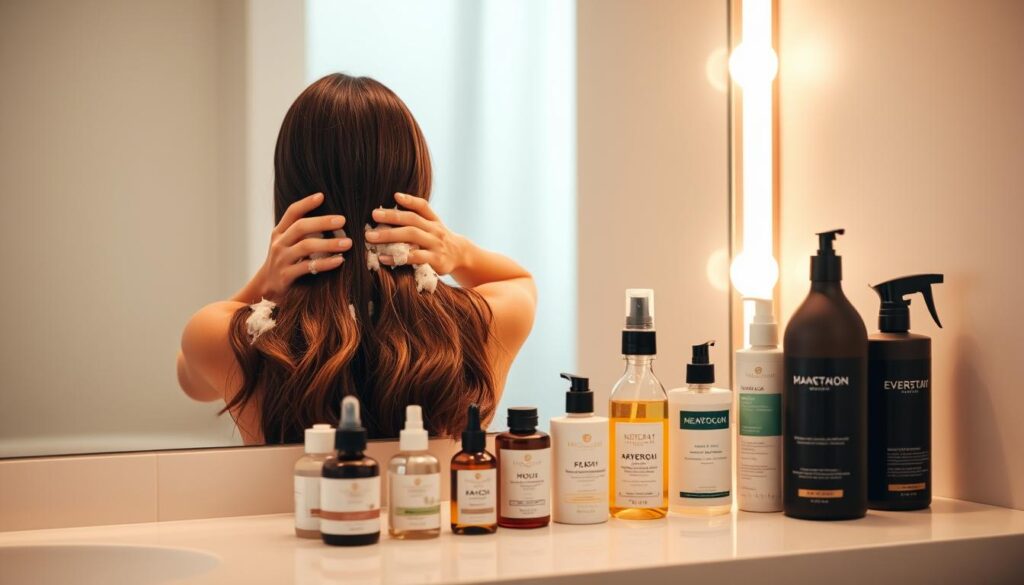
Final Rinse Tips
The final rinse can make a significant difference. Rinsing with cold water helps seal the cuticle, reducing frizz and enhancing shine. This simple step can improve your hair’s overall appearance and make it more resistant to heat damage.
Weekly Hair Masks
Incorporating a weekly hair mask into your routine can provide an intense dose of nourishment. Look for masks containing ingredients like argan oil, keratin, or shea butter, which are known for their protective and restorative properties.
| Hair Type | Recommended Shampoo | Beneficial Mask Ingredients |
|---|---|---|
| Oily Hair | Gentle, oil-balancing | Clay, tea tree oil |
| Dry/Damaged Hair | Moisturising, nourishing | Argan oil, keratin, shea butter |
| Normal Hair | Balanced, gentle cleansing | Coconut oil, vitamin E |
By adopting these washing and conditioning techniques, you can significantly enhance your hair’s resilience to heat styling, ensuring it remains healthy and vibrant.
Drying Your Hair Properly Before Heat Styling
The way you dry your hair can significantly impact its resilience to heat styling tools. Proper drying techniques not only help in reducing damage but also enhance the overall health and appearance of your hair.
Air Drying vs. Blow Drying
When it comes to drying your hair, you have two primary options: air drying and blow drying. Air drying is a gentler method that avoids additional heat, but it can be time-consuming and may not be suitable for everyone, especially those with very thick or curly hair. On the other hand, blow drying can be quicker, but it involves more heat, which can be damaging if not done correctly.
Proper Towel-Drying Techniques
Regardless of whether you air dry or blow dry, how you towel-dry your hair is crucial. Gently blot your hair with a towel instead of rubbing vigorously, which can cause friction and lead to breakage. This simple change can significantly reduce damage.
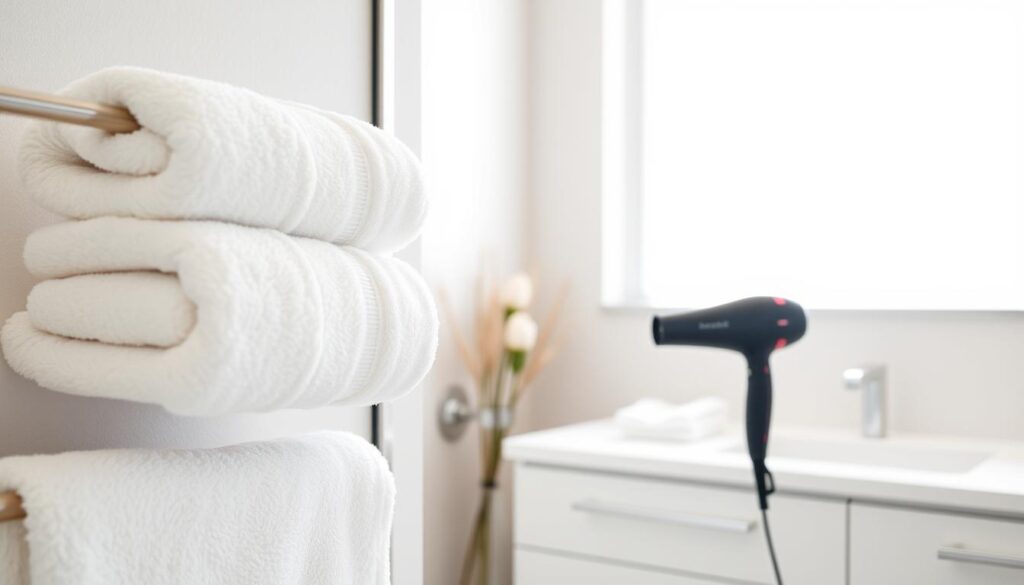
Using a Microfibre Towel
Using a microfibre towel can be beneficial as it is gentler on hair and more absorbent than regular towels, reducing the time needed to dry your hair and minimizing friction.
Low-Heat Blow Drying Methods
If you prefer blow drying, using a low-heat setting can help minimize damage. Keep the dryer at a safe distance from your hair and move it constantly to avoid concentrating heat on one spot. This method, combined with a heat protectant, can significantly reduce the risk of damage.
As a stylist once said, “The key to healthy, beautiful hair is not just about using the right products, but also about adopting the right techniques.” By incorporating these drying techniques into your routine, you’ll be well on your way to protecting your hair from heat damage.
“Healthy hair is not just about genetics; it’s about the care and attention you give it daily.”
Heat Protection Tips Before Straightening Hair
Heat styling can be damaging, but with the right protection tips, you can keep your hair healthy. Straightening your hair can be a daily routine for some, but without proper precautions, it can lead to significant hair damage. Understanding how to protect your hair is crucial.
Before applying heat, several steps can be taken to ensure your hair is adequately protected. This includes using the right products at the right time and preparing your hair properly.
Timing Your Product Application
Applying heat protection products at the right time is vital. Ideally, you should apply a heat protectant before you start styling. This can be in the form of a spray, Serum, or cream. It’s essential to apply these products to damp hair to ensure even distribution.
Sectioning Hair for Even Product Distribution
Sectioning your hair is a crucial step that ensures the even distribution of heat protection products. By dividing your hair into sections, you can apply the product more evenly, making sure every strand is protected. This is particularly important for those with thicker or longer hair.

How Much Product to Use
The amount of product to use can vary depending on your hair type and length. A general rule of thumb is to start with a small amount and adjust as needed. For fine hair, a small amount is often sufficient, while thicker hair may require more product.
Layering Protection Products
Layering different protection products can offer enhanced protection against heat damage. For instance, using a leave-in conditioner followed by a heat protectant spray can provide both moisture and a barrier against heat. Experimenting with different combinations can help you find what works best for your hair.
By following these heat protection tips, you can enjoy straightening your hair while maintaining its health and integrity. It’s all about applying the right products at the right time and preparing your hair properly.
Choosing the Right Heat Settings for Your Hair
Understanding how to adjust heat settings according to your hair type is key to achieving sleek, straight hair without compromising its health. The temperature you choose can significantly impact the well-being of your locks.
Understanding Temperature Settings
Most straightening tools come with adjustable temperature settings. It’s essential to understand what these settings mean for your hair. Generally, lower temperatures (around 150°C to 180°C) are suitable for fine or damaged hair, while higher temperatures (up to 230°C) can be used for thicker, curlier hair.
Matching Heat Levels to Hair Types
Different hair types require different heat levels. For instance, fine hair can be damaged easily, so a lower heat setting is advisable. In contrast, thicker or curlier hair may require higher temperatures to achieve the desired straightness.
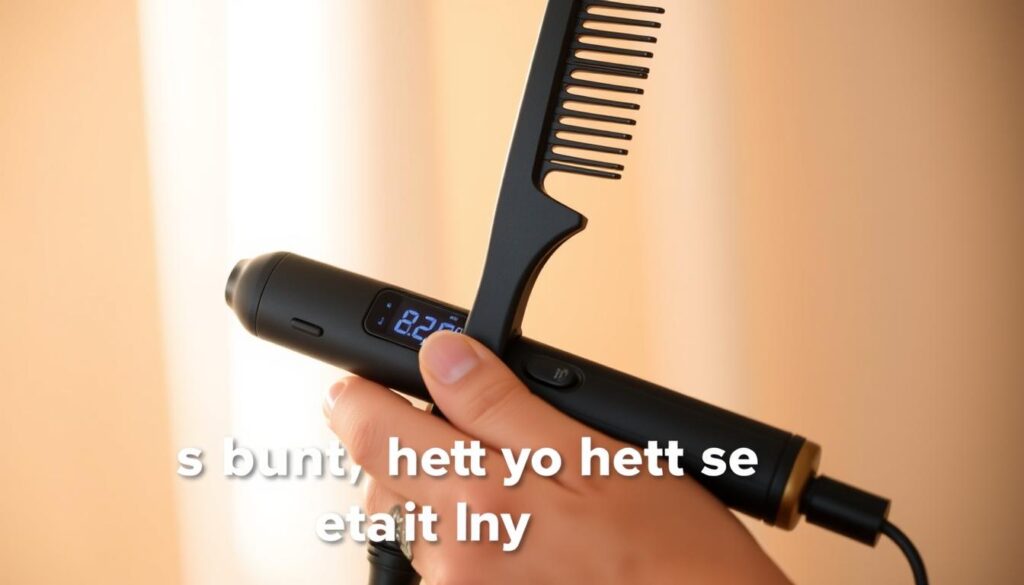
| Hair Type | Recommended Temperature |
|---|---|
| Fine/Damaged Hair | 150°C – 180°C |
| Normal Hair | 180°C – 200°C |
| Thick/Curly Hair | 200°C – 230°C |
Signs You’re Using Too Much Heat
If you notice your hair is becoming excessively dry, brittle, or developing split ends, it may be a sign that you’re using too much heat. Adjusting your temperature settings or using additional heat protection tips can help mitigate this damage.
Quality of Straightening Tools
The quality of your straightening tools also plays a significant role in heat protection. High-quality tools distribute heat more evenly and often come with features like temperature control and automatic shut-off, which can help prevent damage.
By choosing the right heat settings and using quality straightening tools, you can enjoy straight, healthy-looking hair while minimizing the risk of heat damage. For additional Hair Care, consider products that are also beneficial for other Skin types, such as an oily Skin moisturizer or oily Skin treatment, to maintain overall grooming.
Adjusting Heat Protection Based on Hair Type
The key to preventing heat damage lies in adjusting your protection strategy according to your hair type. Different hair types have unique needs when it comes to heat styling, and understanding these needs is crucial for maintaining healthy, beautiful hair.
Fine Hair Protection Strategies
For fine hair, it’s essential to use lightweight heat protectants that won’t weigh your hair down. Heat protectant sprays are often ideal as they provide a thin, even layer of protection without compromising volume or texture.
Thick Hair Protection Needs
Thick hair requires more intensive protection. Thicker serums or creams can be applied to lock in moisture and protect against heat damage. It’s also beneficial to use a higher heat setting, but always with a protective product to prevent damage.
Curly and Coily Hair Considerations
Curly and coily hair types benefit from products that not only protect against heat but also help define curls. Using a leave-in conditioner or curl activator before straightening can help maintain moisture and reduce frizz.
Colour-Treated Hair Special Care
Colour-treated hair is more susceptible to heat damage, which can cause colour to fade faster. Using a colour-protecting heat protectant can help maintain colour vibrancy while protecting against heat.
Damaged or Chemically Processed Hair
For damaged or chemically processed hair, it’s crucial to use nourishing products that repair and protect. Deep conditioning treatments before heat styling can significantly reduce further damage.
Here’s a summary of heat protection strategies for different hair types:
| Hair Type | Recommended Product | Key Benefit |
|---|---|---|
| Fine Hair | Lightweight heat protectant sprays | Protects without weighing hair down |
| Thick Hair | Thicker serums or creams | Locks in moisture and protects against heat |
| Curly/Coily Hair | Leave-in conditioners or curl activators | Defines curls and reduces frizz |
| Colour-Treated Hair | Colour-protecting heat protectants | Maintains colour vibrancy |
| Damaged/Chemically Processed Hair | Nourishing, repairing products | Repairs and protects damaged hair |
Common Heat Protection Mistakes to Avoid
Protecting your hair from heat damage requires more than just using a heat protectant; it involves avoiding common pitfalls. When styling your hair with heat, several mistakes can lead to damage and undermine your hair’s health.
Using Too Much Product
Applying too much heat protectant can weigh your hair down, making it look greasy. It’s essential to use the right amount for your hair type. For instance, fine hair requires a lighter application compared to thicker hair.
Applying Products Incorrectly
The method of application is just as important as the product itself. Ensure you’re distributing the product evenly throughout your hair, focusing on the ends, which are more prone to damage.
Neglecting Regular Trims
Regular trims help prevent split ends, which can travel up the hair shaft if not addressed. This maintenance is crucial for keeping your hair healthy, especially when using heat styling tools.
Straightening Wet or Damp Hair
Straightening your hair when it’s wet or damp can cause significant damage. Always dry your hair properly before using straightening tools to minimize risk.
Overusing Heat Styling Tools
Frequent use of heat styling tools without adequate protection can lead to damage. Try to limit your use of these tools and always use a heat protectant.
| Common Mistake | Consequence | Prevention Tip |
|---|---|---|
| Using too much product | Weighed-down, greasy hair | Use the right amount for your hair type |
| Applying products incorrectly | Uneven protection, damage | Distribute product evenly, focusing on ends |
| Neglecting regular trims | Split ends, breakage | Schedule regular trims |
By being aware of these common mistakes and taking steps to avoid them, you can better protect your hair from heat damage and maintain its health and integrity.
Natural Alternatives for Heat Protection
Natural alternatives for heat protection offer a gentler way to style hair without causing damage. These alternatives can be just as effective as commercial products, with the added benefit of being closer to nature.
Coconut Oil as Heat Protection
Coconut oil is a popular natural alternative for heat protection. It not only shields hair from heat damage but also nourishes it. Applying a small amount of coconut oil to your hair before straightening can help prevent split ends and breakage.
Aloe Vera Benefits
Aloe vera is known for its soothing properties, and it can also serve as a heat protectant. It helps to lock in moisture and protect the hair from the high temperatures of styling tools.
Other Natural Oils and Butters
Other natural oils like argan oil, olive oil, and shea butter can also provide heat protection. These products help to moisturise and condition the hair, making it more resilient to heat styling.
| Natural Product | Benefits |
|---|---|
| Coconut Oil | Nourishes and protects hair from heat damage |
| Aloe Vera | Soothes and locks in moisture |
| Argan Oil | Moisturises and conditions hair |
DIY Heat Protectant Recipes
For those interested in a more personalized approach, DIY heat protectant recipes can be a fun and effective way to protect your hair. Mixing natural ingredients like aloe vera, coconut oil, and vitamin E oil can create a nourishing heat protectant.
By incorporating these natural alternatives into your Hair Care routine, you can enjoy healthier, more resilient hair while still achieving your desired style.
Creating a Complete Pre-Straightening Routine
Before you start straightening your hair, it’s vital to prepare it properly to prevent damage and enhance the styling outcome. A comprehensive pre-straightening routine involves several steps that help protect your hair from heat damage.
Day-Before Preparations
Starting your pre-straightening routine a day before can significantly improve the health and appearance of your hair. Consider applying a nourishing hair mask or deep conditioning treatment to moisturise and repair your hair. This step is crucial for heat protection as it helps to lock in moisture.
Morning-of Routine
On the day you’re straightening your hair, begin with a gentle wash using a suitable shampoo and conditioner for your hair type. Towel-dry your hair gently, and apply a heat protectant spray or Serum to help shield your hair from heat damage.
Quick Protection for On-the-Go Styling
For those in a hurry, using a multi-tasking product that offers both styling and heat protection benefits can be a time-saver. Look for products that are lightweight and won’t weigh your hair down.
Post-Straightening Care
After straightening, allow your hair to cool before touching or styling it further. Using a cool shot on your blow dryer or a cool setting on your straightening tool can help set your style. Regular trims and using a moisturiser suitable for your hair type, such as an oily Skin moisturizer for those with oily scalps, can help maintain hair health.
Conclusion: Maintaining Healthy Hair While Heat Styling
Effective heat protection is crucial when straightening hair to prevent damage and maintain healthy locks. By understanding the importance of heat protection and incorporating the right products and techniques into your Hair Care routine, you can achieve sleek, straight hair without compromising its integrity.
As discussed, using heat protectant products, adjusting heat settings according to your hair type, and adopting pre-straightening routines can significantly reduce heat damage. It’s also essential to consider your overall Hair Care regimen, including washing, conditioning, and drying techniques, to ensure your hair remains healthy and resilient.
While focusing on Hair Care, it’s worth noting that a best skincare routine for oily Skin can also contribute to overall Beauty and confidence. However, the principles of protection and care can be similarly applied to both hair and Skin.
By implementing these heat protection strategies and maintaining a consistent Hair Care routine, you can enjoy straightened hair while preserving its health and vitality.

